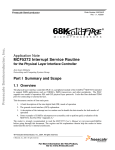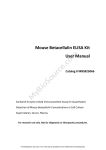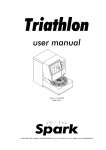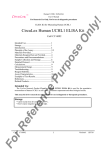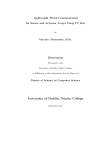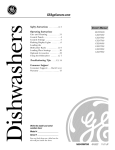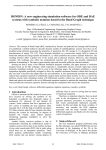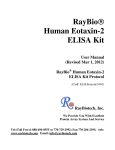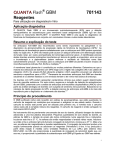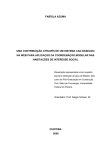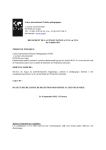Download For Reference Purpose Only!
Transcript
CircuLex Human DJ-1/PARK7 ELISA Kit User’s Manual For Research Use Only, Not for use in diagnostic procedures ELISA Kit for Measuring Human DJ-1/PARK7 On ly! TM CircuLex Human DJ-1/PARK7 ELISA Kit Pu Intended Use................................................ 1 Storage......................................................... 1 Introduction.................................................. 2-3 Principle of the Assay.................................. 3-4 Materials Provided....................................... 4 Materials Required but not Provided........... 5 Precautions and Recommendations............. 6 Sample Collection and Storage.....................7 Detailed Protocol......................................... 8-10 Calculations.................................…............ 10 Measurement Range.................................... 10 Troubleshooting.......................................... 11 Reagent Stability......................................... 11 Assay Characteristics.................................. 12-14 References................................................... 15 Related Products.......................................... 16 rp os e Cat# CY-9050 Intended Use ce The CycLex Research Product CircuLex Human DJ-1/PARK7 ELISA Kit is used for the quantitative measurement of human DJ-1/PARK7 in serum, plasma, cell lysate and other biological samples. en This assay kit is for research use only and not for use in diagnostic or therapeutic procedures. Storage rR ef er • Upon receipt store all components at 4°C. • Don’t expose reagents to excessive light. Fo Cat#: CY-9050 1 Version#: 130326 CircuLex Human DJ-1/PARK7 ELISA Kit User’s Manual For Research Use Only, Not for use in diagnostic procedures On ly! TM Introduction Pu Principle of the Assay rp os e DJ-1 (PARK7/CAP1/RS) was originally cloned as a putative oncogene capable of transforming NIH-3T3 cells in cooperation with H-ras (1), a protein expressed in sperm (2), and a regulator of RNA-protein interactions (3). DJ-1 has also been isolated as a gene associated with autosomal early-onset Parkinson's disease (PD) (4). Taken together, DJ-1 appears to be involved in diverse biological processes (5). First, several lines of evidence suggest that DJ-1 plays a role in the oxidative stress response (6,7). In cu1tured mammalian ce11s, DJ-1 quenches reactive oxygen species and is converted into a variant with a more acidic isoelectric point (6,8). Therefore, DJ-1 protects against reactive oxygen species-induced cell death, and its suppression with small interfering RNA (siRNA) sensitizes cells to such insults (7-10). Second, DJ-1 modulates transcription through interaction with DJ-1-binding protein (11) as well as with protein inhibitor of activated STAT (PIAS) (12). The latter modulates the activity of various transcription factors, Third, DJ-1 has been recognized as a regulatory subunit of an RNA-binding protein (13), Fourth, DJ-1, which is structurally related to the molecular chaperone Hsp31, may have chaperone activity itself, preventing heat-induced aggregation of substrate proteins, including alpha-synuclein (14). In addition, severa1 1ines of evidence suggest that DJ-1 plays a role in human tumorigenesis. First, breast cancer patients have elevated levels of circulating DJ-1 and anti-DJ-1 autoantibodies compared to healthy and non-breast cancer patients (15). Secondly, DJ-1 protein is increased in primary non-small cell lung carcinoma samples (16). Thirdly, treatment of cells from the human lung cancer cell line NCI-H157 with paclitaxel and MEK inhibitor U0126 leads to a decrease in DJ-1 protein expression (16). rR ef er en ce The CircuLex Human DJ-1/PARK7 ELISA Kit employs the quantitative sandwich enzyme immunoassay technique. An antibody specific for Human DJ-1 has been pre-coated onto a microplate. Standards and samples are pipetted into the wells and any DJ-1 present is bound by the immobilized antibody. After washing away any unbound substances, an HRP conjugated antibody specific for DJ-1 is added to the wells. Following a wash to remove any unbound antibody HRP conjugate, the remaining conjugate is allowed to react with the substrate H2O2-tetramethylbenzidine. The reaction is stopped by addition of acidic solution and absorbance of the resulting yellow product is measured at 450 nm. The absorbance is proportional to the concentration of DJ-1. A standard curve is constructed by plotting absorbance values versus DJ-1 concentrations of calibrators, and concentrations of unknown samples are determined using this standard curve. Fo Cat#: CY-9050 2 Version#: 130326 CircuLex Human DJ-1/PARK7 ELISA Kit User’s Manual For Research Use Only, Not for use in diagnostic procedures Summary of Procedure Add 100 µL of diluted sample to the wells Incubate for 1 hour at room temp. Wash the wells Add 100 µL of HRP conjugated anti-DJ-1 antibody On ly! TM Wash the wells rp os e Incubate for 1hour at room temp. Add 100 µL of Substrate Reagent Add 100 µL of Stop Solution Pu Measure absorbance at 450 nm rR ef er en ce The CircuLex Human DJ-1/PARK7 ELISA Kit is designed to measure the concentration of human DJ-1/PARK7 from human serum/plasma, human cell lines, or conditioned medium. The principle of the assay is shown in below. Diluted samples and serially diluted human DJ-1/PARK7 standard solutions are added to an appropriate number of wells of the microtiter plate and incubated. DJ-1/PARK7 in the sample will be bound by the primary anti-DJ-1/PARK7 antibody immobilized in the well (first reaction). After washing, the HRP-conjugated anti-DJ-1/PARK7 antibody is added to each well and allowed to incubate (second reaction). The HRP-conjugated anti-DJ-1/PARK7 antibody will bind to the DJ-1/PARK7 trapped in the well in the first Reaction. After washing, the colorimetric substrate for the enzyme is added to all wells and incubated. The color development is terminated by the addition of a stop solution. The intensity of the color is measured at 450 nm. The concentrations of the samples tested are calculated using the absorbance values of the DJ-1/PARK7 standard solutions assayed at the same time. Fo Cat#: CY-9050 3 Version#: 130326 CircuLex Human DJ-1/PARK7 ELISA Kit User’s Manual For Research Use Only, Not for use in diagnostic procedures Materials Provided On ly! TM All samples and standards should be assayed in duplicate. The following components are supplied and are sufficient for the one 96-well microplate kit. Microplate: One microplate supplied ready to use, with 96 wells (12 strips of 8-wells) in a foil, zip-lock bag with a desiccant pack. Wells are coated with anti-human DJ-1/PARK7 antibody as a capture antibody. rp os e 10X Wash Buffer: One 100 mL bottle of 10X buffer containing 2%Tween®-20 Dilution Buffer: One bottle containing 50 mL of 1X buffer; use for sample dilution. Ready to use. Human DJ-1/PARK7 Standard: One vial containing 3.5 µg of lyophilized human DJ-1/PARK7 20X HRP conjugated Detection Antibody: One vial containing 0.6 mL of HRP (horseradish peroxidase) conjugated anti-human DJ-1/PARK7 antibody. Conjugate Dilution Buffer: One bottle containing 12 mL of Conjugate Dilution Buffer. Substrate Reagent: 20 mL of the chromogenic substrate, tetra-methylbenzidine (TMB). Ready to use. rR ef er en ce Pu Stop Solution: One bottle supplied ready to use, containing 20 mL of 1 N H2SO4. Fo Cat#: CY-9050 4 Version#: 130326 CircuLex Human DJ-1/PARK7 ELISA Kit User’s Manual For Research Use Only, Not for use in diagnostic procedures On ly! TM Materials Required but not Provided • Pipettors: 2-20 µL, 20-200 µL and 200-1000 µL precision pipettors with disposable tips. • Precision repeating pipettor • Orbital microplate shaker • Microcentrifuge and tubes for sample preparation. rp os e • Vortex mixer • Microplate washer: optional (Manual washing is possible but not preferable) • Plate reader capable of measuring absorbance in 96-well plates at dual wavelengths of 450/540 nm. Dual wavelengths of 450/550 or 450/595 nm can also be used. The plate can also be read at a single wavelength of 450 nm, which will give a somewhat higher reading. • Software package facilitating data generation and analysis :optional • Reagent reservoirs • Deionized water of the highest quality. rR ef er en ce • Disposable paper towels Pu • 500 or 1000 mL graduated cylinder. Fo Cat#: CY-9050 5 Version#: 130326 CircuLex Human DJ-1/PARK7 ELISA Kit User’s Manual For Research Use Only, Not for use in diagnostic procedures Precautions and Recommendations • Allow all the components to come to room temperature before use. On ly! TM • All microplate strips that are not immediately required should be returned to the zip-lock pouch, which must be carefully resealed to avoid moisture absorption. • Do not use kit components beyond the indicated kit expiration date. rp os e • Use only the microtiter wells provided with the kit. • Rinse all detergent residue from glassware. • Use deionized water of the highest quality. • Do not mix reagents from different kits. • The buffers and reagents used in this kit contain NaN3 as preservatives. Care should be taken to avoid direct contact with these reagents. • Do not mouth pipette or ingest any of the reagents. Pu • Do not smoke, eat, or drink when performing the assay or in areas where samples or reagents are handled. • Dispose of tetra-methylbenzidine (TMB) containing solutions in compliance with local regulations. • Avoid contact with the acidic Stop Solution and Substrate Solution, which contains hydrogen peroxide. ce • Wear gloves and eye protection when handling immunodiagnostic materials and samples of human origin, and these reagents. In case of contact with the Stop Solution and the Substrate Solution, wash skin thoroughly with water and seek medical attention, when necessary. en • Biological samples may be contaminated with infectious agents. Do not ingest, expose to open wounds or breathe aerosols. Wear protective gloves and dispose of biological samples properly. rR ef er • CAUTION: Sulfuric Acid is a strong acid. Wear disposable gloves and eye protection when handling Stop Solution. Fo Cat#: CY-9050 6 Version#: 130326 CircuLex Human DJ-1/PARK7 ELISA Kit User’s Manual For Research Use Only, Not for use in diagnostic procedures On ly! TM Sample Collection and Storage Serum: Use a serum separator tube and allow samples to clot for 60 ± 30 minutes. Centrifuge the samples at 4°C for 10 minutes at 1,000 x g. Remove serum and assay immediately or store samples on ice for up to 6 hours before assaying. Aliquots of serum may also be stored at below -70°C for extended periods of time. Avoid repeated freeze-thaw cycles. rp os e Plasma: Collect plasma using EDTA-Na2 as the anticoagulant. If possible, collect the plasma into a mixture of EDTA-Na2 and Futhan5 (Nafamostat Mesylate) to stabilize the sample against spontaneous in vitro complement activation. Immediately centrifuge samples at 4°C for 15 minutes at 1,000 x g. Assay immediately or store samples on ice for up to 6 hours before assaying. Aliquots of plasma may also be stored at below -70°C for extended periods of time. Avoid repeated freeze-thaw cycles. Note: Citrate plasma has not been validated for use in this assay. Cell lysate: Prepare cell lysates. Assay immediately or store the samples on ice for a few hours before assaying. Aliquots of the samples may also be stored at below -70°C for extended periods of time. Avoid repeated freeze-thaw cycles. (See below.) rR ef er en ce Pu Other biological samples: Remove any particulates by centrifugation and assay immediately or aliquot and store samples at below -70°C. Avoid repeated freeze-thaw cycles. Fo Cat#: CY-9050 7 Version#: 130326 CircuLex Human DJ-1/PARK7 ELISA Kit User’s Manual For Research Use Only, Not for use in diagnostic procedures On ly! TM Detailed Protocol The CycLex Research Product CircuLex Human DJ-1/PARK7 ELISA Kit is provided with removable strips of wells so the assay can be carried out on separate occasions using only the number of strips required for the particular determination. Since experimental conditions may vary, an aliquot of the human DJ-1/PARK7 Standard within the kit, should be included in each assay as a calibrator. Disposable pipette tips and reagent troughs should be used for all liquid transfers to avoid cross-contamination of reagents or samples. Preparation of Working Solutions rp os e All reagents need to be brought to room temperature prior to the assay. Assay reagents are supplied ready-to-use, with the exception of 10X Wash Buffer, 20X HRP-conjugated Detection Antibody and Human DJ-1/PARK7 Standard. 1. Prepare a working solution of Wash Buffer by adding 100 mL of the 10X Wash Buffer to 900 mL of deionized (distilled) water (ddH2O). Mix well. Store at 4°C for two weeks or -20°C for long-term storage. Pu 2. Prepare HRP conjugated Detection Antibody by 20-fold diluting the 20X HRP-conjugated Detection Antibody with Conjugate Dilution Buffer at the time of assay. Prepare appropriate volume for your assay. Discard any unused HRP-conjugated Detection Antibody after diluted. 3. Reconstitute Human DJ-1/PARK7 Standard with 1.0 mL of ddH2O. The concentration of the human DJ-1/PARK7 in vial should be 3.5 µg/mL, which is referred as a Master Standard of human DJ-1/PARK7. er en Volume of Standard 20 µL of Master Standard 300 µL of Std. 1 (100 ng/ml) 300 µL of Std. 2 (50 ng/ml) 300 µL of Std. 3 (25 ng/ml) 300 µL of Std. 4 (12.5 ng/ml) 300 µL of Std. 5 (6.25 ng/ml) 300 µL of Std. 6 (3.13 ng/ml) - Dilution Buffer 680 µL 300 µL 300 µL 300 µL 300 µL 300 µL 300 µL 300 µL Concentration 100 ng/mL 50 ng/mL 25 ng/mL 12.5 ng/mL 6.25 ng/mL 3.13 ng/mL 1.56 ng/mL 0 ng/mL ef Std.1 Std.2 Std.3 Std.4 Std.5 Std.6 Std.7 Blank ce Prepare Standard Solutions as follows: Use the Master Standard to produce a dilution series (below). Mix each tube thoroughly before the next transfer. The 100 ng/mL standard (Std.1) serves as the highest standard. The Dilution Buffer serves as the zero standard (Blank). rR Note: Do not use a Repeating pipette. Change tips for every dilution. Wet tip with Dilution Buffer before dispensing. Unused portions of Standards should be aliquoted and stored at below -70°C immediately. Avoid multiple freeze and thaw cycles. Fo Cat#: CY-9050 8 Version#: 130326 CircuLex Human DJ-1/PARK7 ELISA Kit User’s Manual For Research Use Only, Not for use in diagnostic procedures Sample Preparation • Serum and plasma samples may require a 10-fold or more dilution. e.g. 25 µL sample + 225 µL Dilution Buffer On ly! TM • Cell lysates and other biological samples might be required 10- to 100-fold dilution. Note: Higher dilution of samples is recommended. rp os e Standard Assay Procedure 1. Remove the appropriate number of microtiter wells from the foil pouch and place them into the well holder. Return any unused wells to the foil pouch, refold, seal with tape and store at 4°C. 2. Dilute samples with Dilution Buffer. (See “Sample Preparation” above.) 3. Pipette 100 µL of Standard Solutions (Std1-Std7, Blank) and diluted samples in duplicates, into the appropriate wells. 4. Incubate the plate at room temperature (ca.25°C) for 1 hour, shaking at ca. 300 rpm on an orbital microplate shaker. Pu 5. Wash 4-times by filling each well with Wash Buffer (350 µL) using a squirt bottle, multi-channel pipette, manifold dispenser or microplate washer. 6. Add 100 µL of HRP conjugated Detection Antibody into each well. ce 7. Incubate the plate at room temperature (ca.25°C) for 1 hour, shaking at ca. 300 rpm on an orbital microplate shaker. 8. Wash 4-times by filling each well with Wash Buffer (350 µL) using a squirt bottle, multi-channel pipette, manifold dispenser or microplate washer. en 9. Add 100 µL of Substrate Reagent. Avoid exposing the microtiter plate to direct sunlight. Covering the plate with e.g. aluminum foil is recommended. Return Substrate Reagent to 4°C immediately after the necessary volume is removed er 10. Incubate the plate at room temperature (ca.25°C) for 10-20 minutes, shaking at ca. 300 rpm on an orbital microplate shaker. The incubation time may be extended up to 30 minutes if the reaction temperature is below than 20°C. ef 11. Add 100 µL of Stop Solution to each well in the same order as the previously added Substrate Reagent. rR 12. Measure absorbance in each well using a spectrophotometric microplate reader at dual wavelengths of 450/540 nm. Dual wavelengths of 450/550 or 450/595 nm can also be used. Read the microplate at 450 nm if only a single wavelength can be used. Wells must be read within 30 minutes of adding the Stop Solution. Note-1: Complete removal of liquid at each step is essential to good performance. After the last wash, Fo Cat#: CY-9050 9 Version#: 130326 TM On ly! CircuLex Human DJ-1/PARK7 ELISA Kit User’s Manual For Research Use Only, Not for use in diagnostic procedures remove any remaining Wash Buffer by aspirating or decanting. Invert the plate and blot it against clean paper towels. Note-2: Reliable standard curves are obtained when either O.D. values do not exceed 0.25 units for the blank (zero concentrations), or 3.0 units for the highest standard concentration. The plate should be monitored at 5-minute intervals for approximately 30 minutes. Note-3: If the microplate reader is not capable of reading absorbance greater than the absorbance of the highest standard, perform a second reading at 405 nm. A new standard curve, constructed using the values measured at 405 nm, is used to determine DJ-1/PARK7 concentration of off-scale samples. The readings at 405 nm should not replace the on-scale readings at 450 nm. rp os e Calculations Average the duplicate readings for each standard, control, and sample and subtract the average zero standard optical density. Plot the optical density for the standards versus the concentration of the standards and draw the best curve. The data can be linearized by using log/log paper and regression analysis may be applied to the log transformation. To determine the DJ-1/PARK7 concentration of each sample, first find the absorbance value on the y-axis and extend a horizontal line to the standard curve. At the point of intersection, extend a vertical line to the x-axis and read the corresponding DJ-1/PARK7 concentration. If the samples have been diluted, the concentration read from the standard curve must be multiplied by the dilution factor. Pu 1. The dose-response curve of this assay fits best to a sigmoidal 5-parameter logistic equation. The results of unknown samples can be calculated with any computer program having a 5-parameter logistic function. It is important to make an appropriate mathematical adjustment to accommodate for the dilution factor. Measurement Range ce 2. Most microtiter plate readers perform automatic calculations of analyte concentration. The calibration curve is constructed by plotting the absorbance (Y) of calibrators versus log of the known concentration (X) of calibrators, using the four-parameter function. Alternatively, the logit log function can be used to linearize the calibration curve (i.e. logit of absorbance (Y) is plotted versus log of the known concentration (X) of calibrators). rR ef er en The measurement range is 1.56 ng/mL to 100 ng/mL. Any sample reading higher than the highest standard should be diluted with Dilution Buffer in higher dilution and re-assayed. Dilution factors need to be taken into consideration in calculating the human DJ-1/PARK7 concentration. Fo Cat#: CY-9050 10 Version#: 130326 CircuLex Human DJ-1/PARK7 ELISA Kit User’s Manual For Research Use Only, Not for use in diagnostic procedures On ly! TM Troubleshooting 1. The Human DJ-1/PARK7 Standard should be run in duplicate, using the protocol described in the Detailed Protocol. Incubation times or temperatures significantly different from those specified may give erroneous results. 2. Poor duplicates, accompanied by elevated values for wells containing no sample, indicate insufficient washing. If all instructions in the Detailed Protocol were followed accurately, such results indicate a need for washer maintenance. rp os e 3. Overall low signal may indicate that desiccation of the plate has occurred between the final wash and addition of Substrate Reagent. Do not allow the plate to dry out. Add Substrate Reagent immediately after wash. Reagent Stability All of the reagents included in the CycLex Research Product CircuLex Human DJ-1/PARK7 ELISA Kit have been tested for stability. Reagents should not be used beyond the stated expiration date. Upon receipt, kit reagents should be stored at 4°C, except the reconstituted Human DJ-1/PARK7 Standard must be stored at below -70°C. Coated assay plates should be stored in the original foil bag sealed by the zip lock and containing a desiccant pack. rR ef er en ce Pu For research use only, not for use in diagnostic or therapeutic procedures Fo Cat#: CY-9050 11 Version#: 130326 CircuLex Human DJ-1/PARK7 ELISA Kit User’s Manual For Research Use Only, Not for use in diagnostic procedures On ly! TM Assay Characteristics 1. Sensitivity The limit of detection (defined as such a concentration of human DJ-1/PARK7 giving absorbance higher than mean absorbance of blank* plus three standard deviations of the absorbance of blank: A blank + 3SD blank) is better than 0.55 ng/mL of sample. * Dilution Buffer is pipetted into blank wells. rp os e Typical standard curve DJ-1/Park7 Standard Curve 2.0 1.0 Pu A450 1.5 0.0 20 40 60 80 100 DJ-1/Park7 conc. (ng/mL) rR ef er en 0 ce 0.5 Fo Cat#: CY-9050 12 Version#: 130326 CircuLex Human DJ-1/PARK7 ELISA Kit User’s Manual For Research Use Only, Not for use in diagnostic procedures 2. Precision On ly! TM Intra-assay Precision (Precision within an assay) Three samples* of known concentration were tested six times on one plate to assess intra-assay precision. • Intra-assay (Run-to-Run, n=6), CV=3.6 – 6.2% * Samples: cell lysates Human DJ-1/PARK7 concentration (ng/mL) 1,012 970 1,031 985 939 952 1,031 939 982 35.1 3.6% 1,048 1,030 999 1,042 923 1,091 1,091 923 1,022 56.9 5.6% 1,838 1,573 1,631 1,759 1,606 1,622 1,838 1,573 1,671 103.5 6.2% Pu 1 2 3 4 5 6 MAX. MIN. MEAN S.D. C.V. rp os e Sample 1 Sample 2 Sample 3 ce Inter-assay Precision (Precision between assays) Three samples* of known concentration were tested in three separate assays to assess inter-assay precision. • Inter-assay (Run-to-Run, n=3), CV=3.3 – 8.9% * Samples: cell lysates en Human DJ-1/PARK7 concentration (ng/mL) Sample 1 Sample 2 Sample 3 rR ef er 1 2 3 MAX. MIN. MEAN S.D. C.V. Fo Cat#: CY-9050 923 1,024 1,064 1,064 923 1,004 72.9 7.3% 953 1,045 1,139 1,139 953 1,046 92.7 8.9% 13 1,735 1,799 1,840 1,840 1,735 1,791 52.9 3.3% Version#: 130326 CircuLex Human DJ-1/PARK7 ELISA Kit User’s Manual For Research Use Only, Not for use in diagnostic procedures On ly! TM 3. Linearity To assess the linearity of the assay, three samples* were serially diluted with the Dilution Buffer to produce samples with values within the dynamic range of the assay. * Samples: cell lysates Linearity rp os e Samlpe 1 Samlpe 2 40 Samlpe 3 30 20 10 0 0 0.2 Pu Human DJ-1/Park7 conc. (ng/mL) . 50 0.4 0.6 0.8 1 rR ef er en ce Sample Dilution Ratio Fo Cat#: CY-9050 14 Version#: 130326 CircuLex Human DJ-1/PARK7 ELISA Kit User’s Manual For Research Use Only, Not for use in diagnostic procedures On ly! TM References 1. D. Nagakubo, T. Taira, H. Kitaura, M. lkeda, K. Tamai, S.M. Iguchi-Ariga and H. Ariga: Biochem. Biophys.Res.Commun.231, 509-513,1997 2. A. Wagenfeld, J. Gromoll and T.G, Cooper Biochem. Biophys. Res. Commun. 251, 545-549, 1998 3. Y. Hod, S.N. Pentyala, T.C. Whyard and M.R. El-Maghrabi: J. Cell. Biochem. 72, 435-444, 1999 rp os e 4. Bonifati, V., Rizzu, P., van Baren, M. J., Schaap, O., Breedveld, G. J., Krieger, E., Dekker, M. C. J, Squitieri, F., Ibanez, P., Joosse, M., van Dongen, J.W., Vanacore, N., van Swieten, J.C, Brice, A., Meco, G., van Duijng, C. M., Oostra, B. A., Heutink, P.: Science 299, 256-259, 2003. 5. Cookson, M. R,: Neuron 37, 7-10, 2003 6. Mitsumoto, A.& Nakagawa, Y.: Free Radica1 Res.35, 885-893, 2001 7. Canet-Aviles, R. M., Wilson, M. A., Mil1er, D. W., Ahmad, R., McLendon, C., Bandyopadhyay, S., Baptista, M. J., Ringe, D., Petsko, G. A. & Cookson, M. R.: Proc. Natl. Acad. Sci. USA 101, 9103-9108, 2004 Pu 8. Taha, T., Saito,Y., Niki,T., Iguchi-Ariga,S.M., Takahashi, K. & Ariga, H.:,EMBO Rep.5, 213-218, 2004 9. Martinat, C., Shendelrnan, S., Jonason, A., Leete, T., Bea1, M,F., Yang, L., Floss, T. & Abeliovich, A.: PLoS Biol, 2, e327, 2004 ce 10.Yokota, T., Sugawara, K., Ito, K., Takahashi, R., Ariga, H.& Mizusawa, H. :Biochem Biophys.Res. Commun, 312, 1342-1348, 2003 en 11. Niki, T., Takahashi-Niki, K., Taira, T., Iguchi-Ariga, S. M. & Ariga, H.: Mol. Cancer Res. 1, 247-261, 2003 , 12. Takahashi, K., Taira, T., Niki, T., Seino, C., lguchi-Ariga, S. M. & Ariga, H.: J. Biol. Chern. 276, 37556-37563, 2001 13. Hod, Y., Pentyala, S.N., Whyard, T.C.& El-Maghrabi, M.R.: J. Cell Biochem.72, 435-444, 1999 er 14. Shendelman, S., Jcmason, A., Manimag, C., Leete, T. & Abeliovich, A.: PLoS Biol.2, e362, 2004 15. F. Le Naour, D.E. Misek, M. C. Krause, L. Deneux, T. J. Giordano, S. Scholl and S.M. Hanash: Clin. Cancer Res. 7, 3328-3335, 2001 rR ef 16. J.P. MacKeigan, CM. Clements, J.D, Lich, R. M. Pope, Y. Hod and J.P. Ting: Cancer Res. 63 6928-6934, 2003 Fo Cat#: CY-9050 15 Version#: 130326 CircuLex Human DJ-1/PARK7 ELISA Kit User’s Manual For Research Use Only, Not for use in diagnostic procedures Related Products Parkinson's disease: * CircuLex Human UCHL1 ELISA Kit: Cat# CY-8092 * CircuLex Mouse UCHL1 ELISA Kit: Cat# CY-8093 * Anti-Human UCHL1/PARK5 Clone YK-3G8: Cat# CY-M1040 Neurological disorder: * CircuLex 14-3-3 Gamma ELISA Kit: Cat#CY-8082 On ly! TM PRODUCED BY en ce Pu rp os e Oxidation: * PA0122 (Pseudomonas aeruginosa) Low Endotoxin: Cat# CY-R2474 * Asp-hemolysin Low Endotoxin: Cat# CY-R2475 ef er CycLex Co., Ltd. 1063-103 Terasawaoka Ina, Nagano 396-0002 Japan Fax: +81-265-76-7618 e-mail: [email protected] URL: http://www.cyclex.co.jp rR CycLex/CircuLex products are supplied for research use only. CycLex/CircuLex products and components thereof may not be resold, modified for resale, or used to manufacture commercial products without prior written approval from CycLex Co., Ltd. To inquire about licensing for such commercial use, please contact us via email. Fo Cat#: CY-9050 16 Version#: 130326
















